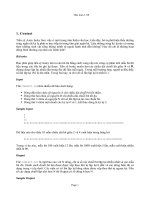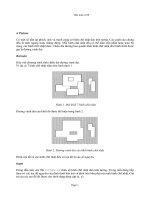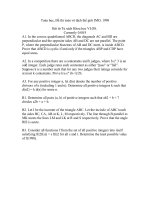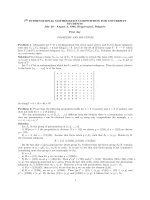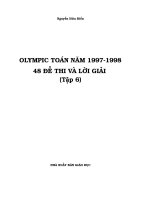C957 93(reapproved 1998)
Bạn đang xem bản rút gọn của tài liệu. Xem và tải ngay bản đầy đủ của tài liệu tại đây (32.14 KB, 3 trang )
Designation: C 957 – 93 (Reapproved 1998)
Standard Specification for
High-Solids Content, Cold Liquid-Applied Elastomeric
Waterproofing Membrane With Integral Wearing Surface1
This standard is issued under the fixed designation C 957; the number immediately following the designation indicates the year of
original adoption or, in the case of revision, the year of last revision. A number in parentheses indicates the year of last reapproval. A
superscript epsilon (e) indicates an editorial change since the last revision or reapproval.
Unglazed Ceramic Tile by the Taber Abraser2
C 717 Terminology of Building Seals and Sealants3
C 719 Test Method for Adhesion and Cohesion of Elastomeric Joint Sealants Under Cyclic Movement (Hockman
Cycle)3
C 794 Test Method for Adhesion-in-Peel of Elastomeric
Joint Sealants3
C 836 Specification for High Solids Content, Cold LiquidApplied Elastomeric Waterproofing Membrane for Use
with Separate Wearing Course3
D 412 Test Methods for Vulcanized Rubber and Thermoplastic Rubbers and Thermoplastic Elastomers—Tension4
D 471 Test Method for Rubber Property—Effect of Liquids4
D 609 Practice for Preparation of Cold-Rolled Steel Panels
for Testing Paint, Varnish, Conversion Coatings, and
Related Coating Products5
D 822 Practice for Conducting Tests on Paint and Related
Coatings and Materials Using Filtered Open-Flame
Carbon-Arc Exposure Apparatus5
D 1133 Test Method for Kauri-Butanol Value of Hydrocarbon Solvents6
D 2370 Test Method for Tensile Properties of Organic
Coatings5
G 23 Practice for Operating Light-Exposure Apparatus
(Carbon-Arc Type) With and Without Water for Exposure
of Nonmetallic Materials7
2.2 U.S. Department of Commerce Standard:
Product Standard PS-1, Construction and Industrial Plywood8
1. Scope
1.1 This specification describes the required properties and
test methods for a cold liquid-applied elastomeric membrane
for waterproofing building decks not subject to hydrostatic
pressure. The specification applies only to a membrane system
that has an integral wearing surface. This specification does not
include specific requirements for skid resistance or fire retardance, although both may be important in specific uses.
1.2 The type of membrane system described in this specification is used for pedestrian and vehicular traffic and in
high-abrasion applications. The membrane may be single- or
multi-component, and may consist of one or more coats (for
example base coat, top coat, etc.). The coat(s) may be built to
the desired thickness in one or more applications. One coat
(base coat) provides the primary waterproofing function and
normally comprises the major amount of organic material in
the membrane. The function of the top coat(s) is to resist wear
and weather. Aggregate may be used as a component of the
membrane system, as all or part of a course, to increase wear
and skid resistance.
1.3 Test methods in this specification require a minimum
0.5-mm (0.020-in.) base coat dry film thickness. Actual thickness required for a particular application and the use of
aggregate in topcoats shall be established by the membrane
manufacturer.
1.4 The values stated in SI units are to be regarded as the
standard. The values given in parentheses are provided for
information purposes only.
1.5 The following safety hazards caveat pertains only to the
test method portion, Section 5, of this specification: This
standard does not purport to address all of the safety problems,
if any, associated with its use. It is the responsibility of the user
of this standard to establish appropriate safety and health
practices and determine the applicability of regulatory limitations prior to use.
3. Terminology
3.1 Definitions—The definitions of the following terms used
in this specification are found in Terminology C 717: cure, dry
film thickness, elastomeric, elongation, seal, substrate, and
waterproofing.
2. Referenced Documents
2.1 ASTM Standards:
C 501 Test Method for Relative Resistance to Wear of
2
Annual Book of ASTM Standards, Vol 15.02.
Annual Book of ASTM Standards, Vol 04.07.
Annual Book of ASTM Standards, Vol 09.01.
5
Annual Book of ASTM Standards, Vol 06.01.
6
Annual Book of ASTM Standards, Vol 14.02.
7
Annual Book of ASTM Standards, Vol 06.04.
8
Available from Superintendent of Documents, U.S. Government Printing
Office, Washington, DC 20402.
3
4
1
This specification is under the jurisdiction of ASTM Committee C-24 on
Building Seals and Sealants and is the direct responsibility of Subcommittee C24.80
on Building Deck Waterproofing Systems.
Current edition approved Sept. 15, 1993. Published December 1993. Originally
published as C 957 – 81. Last previous edition C 957 – 87.
Copyright © ASTM, 100 Barr Harbor Drive, West Conshohocken, PA 19428-2959, United States.
1
C 957
herein, conduct tests on such other substrates as may be
required by the specifier.
5.4 Primer—When required by the manufacturer, use a
primer, as directed by the manufacturer, on all substrate
materials in all test assemblies.
5.5 Low-Temperature Flexibility and Crack Bridging—
Perform the test as specified in the Test Method section of
Specification C 836, and conform to specified requirements.
Make the following changes in the test method of Specification
C 836.
5.5.1 Use equipment similar to that in Test Method C 719.
Other equipment, such as an automatic tension-compression
test machine fitted with an environmental chamber, is permissible, provided it can give the required strain rates and
environment.
5.5.2 Use 25.4 by 25.4 by 50.8 mm (1 by 1 by 2 in.) mortar
blocks.
5.5.3 Cement aluminum angles 75 by 50 by 25 mm (3 by 2
by 1 in.), positioned with the 50-mm legs pointed down, to the
bottom of the mortar blocks with an epoxy adhesive for
insertion into an automatic compression and extension machine.
5.5.4 Test the total membrane system (primers, base coat(s)
and top coat(s)) including any aggregate specified. Total
thickness of the cured membrane, excluding aggregate, shall be
a minimum of 0.5 mm (0.020 in.).
5.5.5 Extend the blocks until the space between each is 1.6
mm (1⁄16 in.) rather than 3.2 mm (1⁄8 in.).
5.6 Adhesion-in-Peel after Water Immersion—Perform the
test as specified in Test Method C 794 with the following
qualifications:
5.6.1 Cement mortar shall be used as the test substrate.
Additional substrates, such as plywood, shall be used when
specified.
5.6.2 Test only the base coat and any primer.
5.6.3 Cast the base coat in the thickness specified by the
manufacturer for one coat of the base coat, or the wet-film
thickness necessary to attain a dry-film thickness of 0.5 mm
(0.020 in.), whichever is greater. Follow the instructions of the
manufacturer regarding the time of placement of the airplane
cloth or aluminum screen.
5.6.4 For testing on plywood, use the A side of Exterior
Type Marine Grade AA, AB, or AC plywood conforming to
U.S. Department of Commerce, Plywood Standard PS-1 as the
substrate.
5.6.5 The sample shall be cured 2 weeks at standard
conditions followed by 1 week at 70°C (158°F).
5.7 Chemical Resistance—Perform the test for change in
tensile strength as specified in Test Method D 471, with the
following qualifications:
5.7.1 Cast test samples of the base coat to a minimum cured
thickness of 0.5 mm (0.020 in.) in accordance with the
directions of the manufacturer. Test any required top coats
separately from the base coat. Cast the top coat test samples
according to Method A of Test Methods D 412 or, in the case
of coatings thinner than 0.16 mm (6.25 mils), by Test Method
D 2370.
3.2 Descriptions of Terms Specific to This Standard:
3.2.1 cold-applied—capable of being applied without heating as contrasted to hot-applied. Cold liquid-applied products
are furnished in a liquid state, whereas hot-applied products are
furnished as solids that must be heated to liquify them.
3.2.2 deck—the structural substrate supporting the plaza
deck system.
3.2.3 wet film thickness—thickness of a liquid coating as it
is applied.
4. Physical Requirements
4.1 Material—Membrane materials shall cure, after application by spreading or spraying, to form an elastomeric film
system composed of one or more layers and capable of
maintaining a seal against water despite the existence or
development of small (1.6 mm (1⁄16 in.) maximum) cracks in
the substrate. It must maintain complete integrity under pedestrian or vehicular traffic.
4.2 Package Stability—The membrane material shall be
capable of meeting the requirements of this specification if
aged for 6 months from the date of manufacture in sealed
containers at a temperature of 27 6 1°C (80 6 2°F).
4.3 Weight Loss— The base coat shall have an average
weight loss not exceeding 40 % when tested as specified in the
Test Method section of Specification C 836. A separate top coat
or primer, or both, if required by manufacturer, shall comply
with the manufacturer’s specifications.
4.4 Low-Temperature Flexibility and Crack Bridging—
When tested as specified in 5.5, the base coat shall exhibit no
cracking. A separate top coat may crack provided that the base
coat beneath maintains its integrity.
4.5 Adhesion-in-Peel After Water-Immersion—The average
peel strength of the base coat shall be not less than 875 N/m (5
lbf/in.) on concrete and not less than 525 N/m (3 lbf/in.) on
plywood when tested as specified in 5.6.
4.6 Chemical Resistance—The separate membrane components, excluding primer and aggregate, shall have a minimum
average tensile retention of 70 % in water, 70 % in ethylene
glycol, and 45 % in mineral spirits when tested as specified in
5.7.
4.7 Weathering Resistance and Recovery from Elongation—
The average recovery from elongation shall be no less than
90 %, the average tensile retention shall be no less than 80 %,
and the average elongation retention shall be no less than 90 %
when tested as specified in 5.8.
4.8 Abrasion Resistance—The weight loss shall be no
greater than 50 mg when tested as specified in 5.9.
5. Test Methods
5.1 Standard Conditions—Standard conditions for all tests
shall be 23 6 2°C (70 to 77°F) and 50 6 5 % relative
humidity:
5.2 Conditioning and Mixing:
5.2.1 Store all membrane materials to be tested in an
unopened container at standard conditions for at least 24 h
before preparing any test specimens.
5.2.2 Follow the manufacturer’s instructions for all mixing
and preparation of membrane materials.
5.3 Substrates—In addition to the substrates specified
2
C 957
After weathering, allow the specified samples to equilibrate for
at least 24 h under standard conditions. Cut out the samples
with the Die C. Set the jaws of the tension tester 51 mm (2 in.)
apart. Place the bench marks on the sample pieces, as specified
in Test Methods D 412. Following the specified procedures,
test the sample pieces for tensile strength and elongation, using
a crosshead speed of 500 mm (20 in.)/min. Allow them to
recover for 30 min and measure elongation after recovery.
Determine recovery as follows:
5.7.2 Cure all test samples for 3 weeks at standard conditions.
5.7.3 For each test liquid, cut at least five dumbbells as
specified in Method A of Test Methods D 412, using Die C. In
addition, cut and retain ten dumbbells as a control.
5.7.4 The test liquids shall be water, ethylene glycol, and
mineral spirits of Kauri Butanol Value 33 to 35, as determined
by Test Method D 1133.
5.7.5 Immerse the test samples in test liquids for 336 h (14
days). Liquid temperature shall be 23 6 1°C (73 6 2°F). Age
the ten control dumbbells under standard conditions for 2
weeks.
5.7.6 Test the dumbbells and calculate the tensile properties
as specified in Test Methods D 412. Make the crosshead speed
500 mm (20 in.)/min, and set the jaws 51 mm (2 in.) apart. If
an extensiometer is used, make its gage length 25 6 0.25 mm
(1.00 6 0.01 in.).
5.7.7 Determine tensile and elongation retention as follows:
Pt
TR 5 P 3 100
R5
E B – ER
3 100
EB
(2)
where:
R 5 percent recovery,
EB 5 percent elongation at break, and
ER 5 percent elongation after recovery.
Tensile and elongation retention are defined in 5.7.7.
5.9 Abrasion Resistance—Perform the test as specified in
Test Method C 501, with the following qualifications:
5.9.1 Cast test samples of the entire membrane excluding
aggregate to a minimum total cured thickness of 0.5 mm (0.020
in.) on a 102 mm (4-in.) square steel panel 3 mm (0.125 in.)
thick with a 6.33-mm (1⁄4-in.) hole drilled in the center. Prepare
panels as specified in Practice D 609. Steel shall be Type 3.
Preparation shall be Method D.
5.9.2 Cure the samples 14 days at standard conditions
followed by 7 days at 70 6 2°C (158 6 4°F) in a circulating
hot-air oven.
5.9.3 Run test for 1000 cycles using 1000-g weight and the
CS-17 abrasion wheel.
(1)
c
where:
TR 5 percent retention of tensile property,
Pt 5 property after test exposure, and
Pc 5 property of the control.
5.8 Weathering Resistance and Recovery from Elongation:
5.8.1 Cast a free film of the total membrane system,
excluding any aggregate, on release paper or other suitable
substrate specified by the manufacturer to a minimum cured
thickness of 0.5 mm (0.020 in.), of sufficient size to provide at
least twenty dumbbell-shaped samples as specified in Test
Methods D 412, Die C.
5.8.2 Cure the film 21 days at standard conditions followed
by 7 days at 70 6 2°C (158 6 4°F) in a circulating hot-air
oven.
5.8.3 Cut sheets of a size such that at least ten dumbbell
samples as specified in Test Methods D 412, Die C, can be cut
after weathering and another ten dumbbells retained as a
control. Expose the sheets for 500 h in an accelerated weathering apparatus as specified in Practice G 23, Type E, EH, F, or
G in accordance with the methods specified in Practice D 822.
6. Marking
6.1 The date of production shall be marked on each package.
7. Report
7.1 The test report shall include a brief description of the
system tested including thicknesses of layers of material,
substrates used on and whether a primer was used.
8. Keywords
8.1 liquid-applied; membrane; waterproofing
The American Society for Testing and Materials takes no position respecting the validity of any patent rights asserted in connection
with any item mentioned in this standard. Users of this standard are expressly advised that determination of the validity of any such
patent rights, and the risk of infringement of such rights, are entirely their own responsibility.
This standard is subject to revision at any time by the responsible technical committee and must be reviewed every five years and
if not revised, either reapproved or withdrawn. Your comments are invited either for revision of this standard or for additional standards
and should be addressed to ASTM Headquarters. Your comments will receive careful consideration at a meeting of the responsible
technical committee, which you may attend. If you feel that your comments have not received a fair hearing you should make your
views known to the ASTM Committee on Standards, at the address shown below.
This standard is copyrighted by ASTM, 100 Barr Harbor Drive, PO Box C700, West Conshohocken, PA 19428-2959, United States.
Individual reprints (single or multiple copies) of this standard may be obtained by contacting ASTM at the above address or at
610-832-9585 (phone), 610-832-9555 (fax), or (e-mail); or through the ASTM website (www.astm.org).
3
